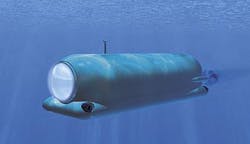General Atomics to provide lithium ion batteries for special operations mini-submarines
CRANE, Ind., 3 Sept. 2013. U.S. Navy power electronics experts needed lithium-ion batteries for prototype mini-submarines designed to transport combat swimmers such as Navy SEALs covertly while minimizing swim time to maintain combat effectiveness. They found their solution from General Atomics in San Diego.
Officials of the Naval Surface Warfare Center in Crane, Ind., have awarded a $12.5 million contract to General Atomics for lithium ion batteries to be used on the Dry Combat Submersible program of U.S. Special Operations Command (SOCOM) at MacDill Air Force Base, Fla.
The batteries and accessories will be used on Navy submersible vehicles as primary sources of power, Navy officials say. General Atomics has experience in nuclear and alternative energy, electromagnetic aircraft launch and recovery systems, and unmanned aerial vehicles (UAVs) that rely on battery power.
The SOCOM Dry Combat Submersible program involves two separate initiatives -- the Dry Combat Submersible-Light (DCS-L) program and the Dry Combat Submersible (DCS). Both initiatives are developing technology to deliver combat swimmers to their mission areas ready to fight, rather than exhausted by long swims.
Submarine experts at the General Dynamics Electric Boat in Groton, Conn., are developing the DCS-L, and those from the Lockheed Martin Corp. Mission Systems and Training segment in Palm Beach, Fla., are developing the DCS.
The two sizes of mini-submarines are intended to operate from combat support surface ships or submarines. They are to be one-atmosphere special operations dry combat submersibles that will be free-swimming vehicles capable of delivering and extracting teams of combat swimmers.
USSOCOM officials are interested in dry combat submersibles that can move at speeds of at least five knots, at depths to 200 feet, with provisions for two pilots.
These dry submersibles should be sized to transport aboard C-5 or C-17 cargo jets, or in standard 40-foot surface ship containers. The submersibles are to have military radios, military sonars, and high power batteries.
These submersibles would operate from surface support ships or submarines equipped with pressure-proof shelter systems either military or commercial, or future generations of the Dry Deck Shelter (DDS).
The General Dynamics Dry Combat Submersible-Light will be about 24 feet long with moderate endurance and moderate passenger and cargo capability that will be operated from specially configured commercial surface ships.
The larger Lockheed Martin version of the Dry Combat Submersible will be about 38 feet long with high endurance and high passenger and cargo capability that will be operated from specially configured commercial surface ships, and potentially from future submarine shelter systems.
Also involved in the SOCOM Dry Combat Submersible program are Oceaneering International Inc. in Houston and L3 Communications in New York.
For more information contact General Atomics online at www.ga.com, or the Naval Surface Warfare Center Crane at www.navsea.navy.mil/nswc/crane.



